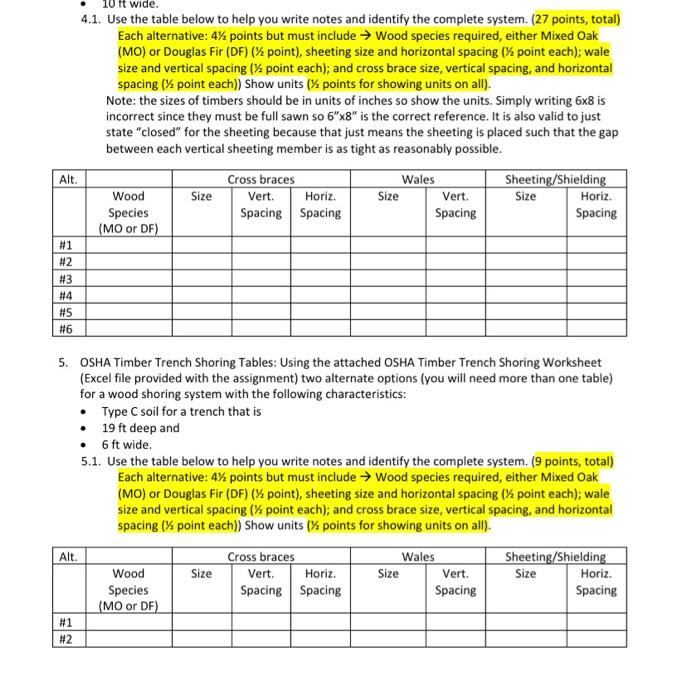10 ft wide. 4.1. Use the table below to help you write notes and identify the complete system. (27 points, total) Each alternative: 4 points but must include Wood species required, either Mixed Oak (MO) or Douglas Fir (DF) ( point), sheeting size and horizontal spacing ( point each); wale size and vertical spacing ( point each); and cross brace size, vertical spacing, and horizontal spacing ( point each)) Show units ( points for showing units on all). Note: the sizes of timbers should be in units of inches so show the units. Simply writing 6x8 is incorrect since they must be full sawn so 6"x8" is the correct reference. It is also valid to just state "closed" for the sheeting because that just means the sheeting is placed such that the gap between each vertical sheeting member is as tight as reasonably possible. Alt. Wales Size Wood Species (MO or DF) Cross braces Vert. Horiz. Size Spacing Spacing Size Sheeting/Shielding Horiz. Spacing Vert. Spacing #1 #2 #3 #4 #5 #6 5. OSHA Timber Trench Shoring Tables: Using the attached OSHA Timber Trench Shoring Worksheet (Excel file provided with the assignment) two alternate options (you will need more than one table) for a wood shoring system with the following characteristics: Type C soil for a trench that is 19 ft deep and 6 ft wide. 5.1. Use the table below to help you write notes and identify the complete system. (9 points, total) Each alternative: 4% points but must include Wood species required, either Mixed Oak (MO) or Douglas Fir (DF) ( point), sheeting size and horizontal spacing ( point each); wale size and vertical spacing ( point each); and cross brace size, vertical spacing, and horizontal spacing ( point each)) Show units ( points for showing units on all). Alt. Wales Cross braces Vert. Sheeting/Shielding Size Size Horiz. Size Vert. Horiz. Wood Species Spacing Spacing Spacing Spacing (MO or DF) #1 #2 10 ft wide. 4.1. Use the table below to help you write notes and identify the complete system. (27 points, total) Each alternative: 4 points but must include Wood species required, either Mixed Oak (MO) or Douglas Fir (DF) ( point), sheeting size and horizontal spacing ( point each); wale size and vertical spacing ( point each); and cross brace size, vertical spacing, and horizontal spacing ( point each)) Show units ( points for showing units on all). Note: the sizes of timbers should be in units of inches so show the units. Simply writing 6x8 is incorrect since they must be full sawn so 6"x8" is the correct reference. It is also valid to just state "closed" for the sheeting because that just means the sheeting is placed such that the gap between each vertical sheeting member is as tight as reasonably possible. Alt. Wales Size Wood Species (MO or DF) Cross braces Vert. Horiz. Size Spacing Spacing Size Sheeting/Shielding Horiz. Spacing Vert. Spacing #1 #2 #3 #4 #5 #6 5. OSHA Timber Trench Shoring Tables: Using the attached OSHA Timber Trench Shoring Worksheet (Excel file provided with the assignment) two alternate options (you will need more than one table) for a wood shoring system with the following characteristics: Type C soil for a trench that is 19 ft deep and 6 ft wide. 5.1. Use the table below to help you write notes and identify the complete system. (9 points, total) Each alternative: 4% points but must include Wood species required, either Mixed Oak (MO) or Douglas Fir (DF) ( point), sheeting size and horizontal spacing ( point each); wale size and vertical spacing ( point each); and cross brace size, vertical spacing, and horizontal spacing ( point each)) Show units ( points for showing units on all). Alt. Wales Cross braces Vert. Sheeting/Shielding Size Size Horiz. Size Vert. Horiz. Wood Species Spacing Spacing Spacing Spacing (MO or DF) #1 #2







